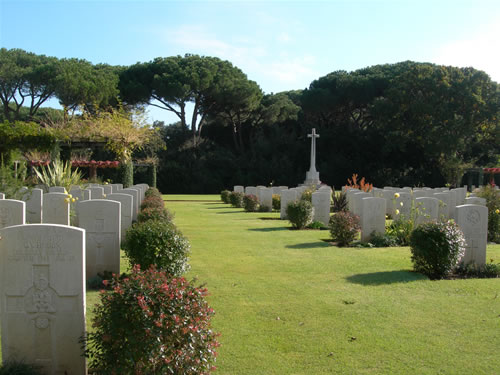Beach Head War Cemetery

The Anzio landings were conducted early in the morning of January 22 by a combined British-American force under 6th U.S. Corps (Fifth Army) command. The enemy was evidently caught off-guard, for the port was found basically intact and resistance was, at least initially, light. There were only three German engineer companies and one panzer grenadier battalion defending 40 miles of coast here. The area selected for the bridgehead was occupied by the 1st British Division and the 3rd U.S. Division by nightfall the next day. However, their progress was held up by enemy reinforcements as the Germans determined to hold the Gustav Line and contain this new bridgehead which had been established behind it. They were successful for four months.
Canadians were represented at Anzio by the 1st Canadian Special Service Battalion* in the First Special Service Force, a combined U.S.- Canadian unit. The Force landed at the beachhead February 1 and immediately took charge of over one-quarter (the southern end) of Anzio's 30-mile-front. On February 16, the Germans attacked the port, effectively inserting a wedge in the Allied front, and then aimed for the beachhead. The 18th was a dire day for the Force, but thanks to pressure from allies to the south and their own determination, the tide began to turn on the 19th, and on the 20th the enemy gave up this assault. (An Allied attack on Cassino was occurring at roughly the same time.) The Germans tried again February 29, but failed at a cost of 111 soldiers taken prisoner against only five wounded members of the Force. From March 1st on, the bridgehead was secure. The Force, meanwhile, conducted raids against enemy positions.
The Allies eventually broke out from the beachhead, beginning May 23, with the Force attacking northeast. Two days later Cisterna was captured and then the Anzio group finally linked up with U.S. troops advancing from Terracina. In the latter days of May, the fighting took a heavy toll on the Canadians. The Force repelled fierce armoured attacks on the 28th and 30th. But in the end, the Fifth Army was reunited and ready to advance to Rome.
From March 27 - May 6, forty two tunnelers from the Royal Canadian Engineers, helped construct an underground command post for Fifth Army Headquarters; in addition, an U.K. squadron provided cover for the bridgehead for 16 weeks, destroying 19 enemy fighters and damaging countless others. Estimated that 562 Canadians died as a result of this campaign.
Directions
The Beach Head War Cemetery is located just north of Anzio, a small seaside resort in the province of Rome about 60 kilometres south of the capital. It was originally a casualty clearing station which lay close to a site for burials that came directly from the battlefield following the Anzio landings in January 1944. These burials along with concentrations of burials from surrounding temporary cemeteries were brought together after the Allied armies moved forward. In all, the cemetery contains 2,313 graves, 291 of them unknown and most of them from the U.K., followed by Canada. The majority of these war dead fell between January-June 1944. There are 69 Canadian graves, including one unknown and four members of the U.K.. Most (62) of the Canadian soldiers were members of the First Special Service Force. There is also one First World War grave here (not Canadian).
The United States maintains two cemeteries in Italy, one in nearby Nettuno (the other is in Florence).
- Date modified: